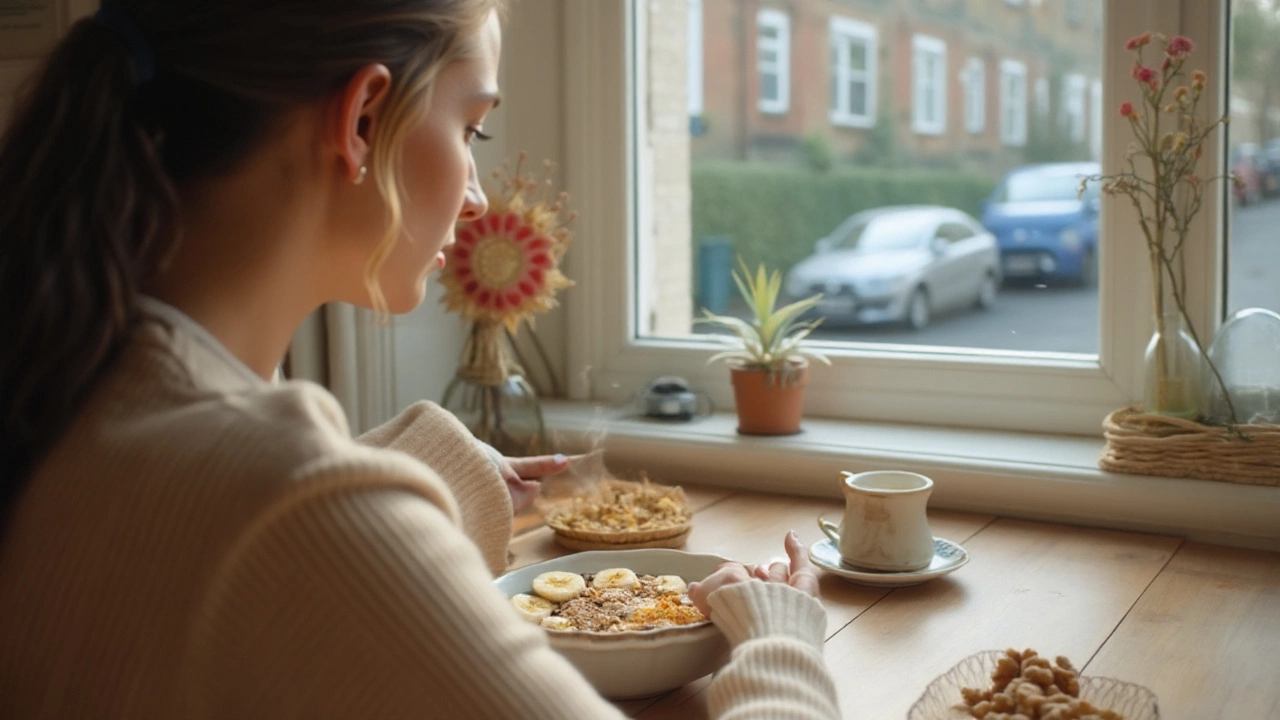Barely slept, sweaty palms, and your mind feels like it's running a marathon—yep, it’s driving test day. It’s wild how a chunk of laminated plastic can make your heart do backflips at breakfast. If you’re the type who can’t down a sausage roll without your nerves twisting, you’re not alone. Countless learners dread test day, and what you eat before you get behind the wheel—believe it or not—can actually tilt the odds in your favor. Food isn’t just for fuel; it shapes everything from your brain chemistry to your mood. Some things will make you sharper and cooler under pressure. Other stuff? Let’s just say a triple espresso and a family-sized chocolate bar will probably have you jitterier than ever. What if I told you the right foods can really, honestly, help settle your nerves and help you think clearly as you edge into the test centre car park? Ready for something that actually works? Here’s what to eat (and what to avoid) before your driving test—and why it’s not just old wives’ tales playing in the background.
Why Your Pre-Test Meal Matters More Than You Think
Stress flips a switch inside you. When your body gets anxious—like, “Oh no, what if I stall at the roundabout?”—your adrenal system kicks in. Heart rate spikes. Blood sugar gets weird. That’s why you feel butterflies, sweaty hands, or a sudden urge to sprint to the loo. Food plays with these systems, either calming things down or pushing you further into overdrive. The right pre-test meal triggers neurotransmitters like serotonin (the chill-out brain chemical) and dopamine (the focus one). For example, a 2018 study from King’s College London showed that people with higher blood sugar swings were more likely to feel anxious before stressful events, like exams. Eating the right stuff gives you a steady release of energy, keeping you clear-headed instead of panicky or spaced out.
Ever eaten a sugary cereal for breakfast and found yourself snapping at the smallest things two hours later? That’s your blood sugar tanking. The last thing you want moments before your manoeuvre is a hunger-fuelled crash (and burn). It’s not just about avoiding a rumbling tummy—picking brain-boosting foods is a real game changer. The foods you should be grabbing are ones that help release energy slowly and offer comfort—without turning your mind into soup. If you pick the right carbs, proteins, and healthy fats, your brain will thank you by staying switched on and cool, minutes before the examiner steps in your car.
The other big key? Habit. If you slam back a fry-up and five coffees every morning, don’t suddenly opt for carrot sticks and chamomile tea right before you have to do your three-point turn. A driving test is not the moment for wild experiments. Go with stuff you know sits easily in your stomach—otherwise, you’re swapping one problem (nerves) for another (racing to the nearest toilet).
The Best Nerve-Soothing Foods and Why They Work
You want something light but satisfying, nothing greasy or too wild. Science backs the idea that certain foods really do take the edge off. Here’s the inside scoop:
- Oats – They’re slow-release carbs, so a bowl of porridge keeps blood sugar steady and tames nerves by fuelling your brain all morning. Oats also trigger those chill-out brain chemicals you want on your side.
- Bananas – One of the best quick options. Bananas are loaded with vitamin B6 and magnesium, a combo that helps your body produce serotonin. Several British researchers say that magnesium is nature’s tranquilizer, stopping nerves from jumping everywhere.
- Eggs – They’re high in choline, which boosts focus. Eggs also have protein, which means you feel satisfied without turning heavy or sleepy.
- Natural yoghurt – Believe it or not, gut health affects your mood. Yoghurt with live cultures helps keep your insides in balance and as a bonus, it’s very gentle if your nerves already have your stomach doing flips.
- Nuts—especially walnuts or almonds – Full of magnesium and omega-3s, which help lower levels of the stress hormone cortisol. Don’t eat handfuls (save that for Netflix night), but a small portion can work wonders.
- Berries – Blueberries and strawberries have antioxidants and vitamin C, proven in a 2015 University of Reading study to lower physical signs of stress (like, say, sweaty palms and jitters).
These foods make your brain fire on all cylinders. Add some wholegrain toast or a simple smoothie, and that’s a breakfast that keeps nerves in check without making you feel like a lead balloon. If your test is later in the day, a lunch of lightly grilled chicken or tofu, brown rice, and green beans keeps things balanced. Even a humble tuna sandwich on wholemeal bread works—tuna is high in omega-3s, which actually help reduce anxiety (according to a study from the University of Vienna, people who eat omega-3s regularly have calmer reactions to pressure).
What about drinks? Water tops everything. Hydration keeps your mind sharp; even a slight dehydration can make you fuzzy-minded or sleepy. If you need a hot drink for comfort, skip the builder’s tea with four sugars or a large latte. Try green tea—yes, it has caffeine, but it’s balanced with L-theanine, which smooths out jitters. Or stick with warm water and lemon for something calming.

Foods and Drinks That Can Make Anxiety Worse
Play it safe—there’s a bunch of foods and drinks more likely to send your nerves into orbit than soothe them. Here’s what you should steer clear of on driving test day:
- Refined sugar – That glazed doughnut or chocolate bar? Tempting, but you’ll crash harder than a learner in their first parallel park. Sugar spikes your blood glucose so high you’ll get a burst, then a drop, leading to foggy thinking and worse nerves.
- Caffeine overload – Some caffeine can give a brain boost, but overdo it and expect sweaty palms, racing heart, and the inability to sit still. An espresso shot or half a cup of coffee is fine if you’re used to it, but don’t go near energy drinks like Red Bull. They’ll make you feel like you’re strapped to a rocket.
- Greasy fast food – Sausage rolls, fried chicken, or a big fries can make you sluggish and might upset your stomach—just what you don’t need in the waiting room. Grease also slows your digestion, so you’ll be tired and foggy when you should be sharp.
- Processed snacks – Crisps, cheese puffs, packaged pastries and even some breakfast bars are just sugar bombs with salt, preservatives, and little actual fuel. They mess up your blood sugar and leave you more anxious.
- Too much dairy – A plain yoghurt is good, but a massive cheese toastie or whole-milk latte might sit heavy and make your gut grumble.
Avoiding these is all about making sure there’s nothing in your system that’ll magnify nerves, trigger stomach problems, or tank your energy. If you usually have a bacon butty, do yourself a favor and keep it simple instead—you want your body’s focus on your test, not a food-induced wrestling match in your gut.
How to Time Your Meals for Maximum Calm
Timing gets overlooked, but it’s a big deal. You don’t want to feel stuffed and sluggish, but a totally empty stomach is just as bad. A good rule: aim to eat your main pre-test meal 90 minutes to two hours before your appointment. That gives you time to digest but means energy is still flowing when you need it most. If your test is at 8:30am, go for breakfast around 7am—oats, banana, maybe a boiled egg or a berry yoghurt, plus a glass of water. For late morning tests, stick with a hearty but familiar breakfast, and maybe a handful of almonds or a banana as a mid-morning, 30-minute-before snack.
If you’re afternoon-bound, lunch should hit 1.5 to 2 hours before—you’d be surprised how often people run late, skip meals, and then show up with a rumbling stomach, mind going blank from hunger. For an extra boost, a few sips of water or a sugar-free electrolyte drink just before your test can give you a lift—especially if nerves usually make you break out in a cold sweat.
Definitely don’t try to power through with no food, hoping you’ll be less distracted. Hunger sends your brain into panic and distraction mode. In a 2022 review at the University of Nottingham, students who skipped breakfast before a practical exam did way worse than those who ate—even if it was just a simple bowl of oats.
If you really don’t feel like you can stomach a full meal, go light. A slice of wholegrain toast, a banana, or a smoothie is far better than nothing, and more likely to keep your focus on the road rather than the next snack bar.

Bonus Hacks to Keep Calm and Carry On
So maybe food alone can’t work magic, but it’s a big chunk of the battle. Want next-level calm? Stack your food choices with a couple of smart extras:
- Get your stuff ready the night before: Don’t let a panicked scramble for your licence kick off the day. Load up your bag with snacks, a bottle of water, and anything else you might want after you pass (or just to ease the nerves right after).
- Don’t try anything new on the day: Driving test morning is not the time to experiment with spicy food, cheeky supplements, or a new protein bar. Stick to what works for you.
- Add a little movement: A quick walk, some stretches, or a series of deep breaths not only boosts endorphins but also helps your body process your food better.
- Consider peppermint: Peppermint tea or sucking on a mint has been shown in several NHS clinics to help with mild stomach queasiness—that weird feeling that hits when nerves hit full blast. It’s a tiny ritual that can ground you.
- Keep confidence snacks on hand: A small banana, a granola bar (with real oats and nuts, not just sugar), or a handful of blueberries can be a good backup if you feel energy levels dipping before your slot.
There’s no shame in feeling nervous for your driving test—most people do. The good news is that choosing the right food puts you firmly in the driver’s seat (pun intended). Fisherman’s Breakfast? Not today. But oats, bananas, a bit of yoghurt, some nuts, and water—those can take your nerves down a notch or two. Above all, trust your gut—literally and figuratively. Feed it good stuff, and it’ll help you focus on the only thing that matters: smashing that test and snagging your licence.

